In epithelial cell research, there are different types of cells which are typically cultured. We will focus on epithelial cells. Epithelial tissue lines the surface and cavities of an organ. Epithelium includes your skin tissue, but it also lines the alimentary canal, organs and blood vessels. Epithelial cell cultures may be used for drug discovery or other applications that explore the transport or diffusion of a substance through an epithelial monolayer. Such a tissue research study requires a confluent monolayer that completely covers the culture substrate it is grown on.
- Automated TEER Measurement System
PC-controlled high throughput TEER measurement for epithelial monolayer
Automates TEER measurement and data logging for use with HTS well plates
- PC controlled positioning
- Data acquisition in LabView
- Manufacturer specific electrodes available for 24 and 96-well HTS plates
- Plate configuration files and sample sequences are user definable
- Two user-defined rinse locations
- Manual mode
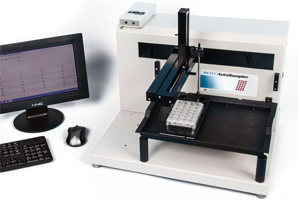
- Ussing System for Epithelial Research
Non-destructive TEER measurement for epithelial tissue
- Direct connect low-resistance electrodes
- Simple operation, easy to control temperature and clean after use
- Luer type leak-free attachment of tubing and electrodes
- Recessed electrode ports avoid bubble formation
- Secure membrane holding by sharp stainless steel pins or O-ring
- Specialized chamber adapts cell culture insert (Costar Snapwell) for monolayer cell culture
- Chambers with rectangular openings for tubular tissues from small animals
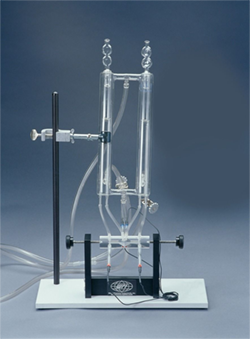
- HTS Electrodes for Use with the EVOM2
For high throughput screening (HTS) in cell culture filter plates
- Designed for use with 24-well HTS plate (Corning Costar and BD Falcon) and with 96-well plates (Millipore)
- Improved accuracy down to 5 Ω
- Sterilized with EtO, alcohol or bactericide
- Compatible with the EVOM, EVOM2, ERS, ERS2 (Millipore)
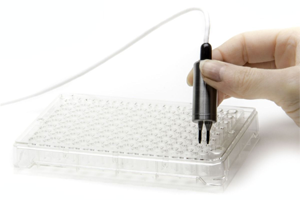
- Replacement REMS HTS Electrode
Replacement electrodes for use with REMS robotic TEER measurement system
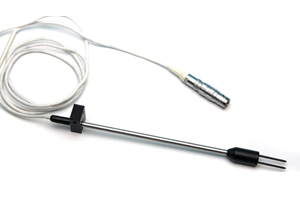
- Epithelial Volt/Ohm (TEER) Meter
Non-destructively test for epithelial monolayer confluence in 2D cell cultures
- Measures trans-epithelial electrical resistance or trans-epithelilal voltage
- Compatible with 12 and 24 well culture plate systems out of the box
- Includes industry standard STX2 hand held “chopstick” electrodes
- Analog output for recording resistance or voltage measurements
- Auto ranging from 0-10 KΩ
- Battery powered
- Manual TEER measurement of epithelial cells in 6, 12, 24 and 96* well plates
- BNC output for data acquisition system
- Compatible with EndOhm chambers
- *96-well plate measurement requires an STX100 series electrode.
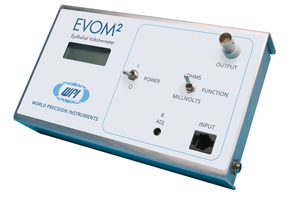
- Cell Culture Cup Chambers for TEER Measurement
For TEER measurement of epithelial and endothelial cell cultures
- The new EndOhm chamber upper mount is made of polycarbonate and unaffected by alcohol
- The glass chamber is easier to clean and more crack resistant than the prior version
- Compatible with original EVOM and EVOM2™ meters
- Adjustable apical electrode height
- Crystal clear glass chamber allows visualization of apical electrode positioning (G version)
- New insert holder with 120º tri-supports for three leg inserts (G version)
- Three sizes cover a range of well cup sizes from a variety of manufacturers
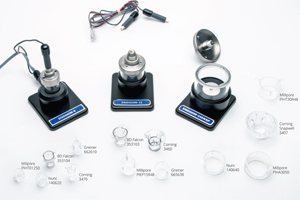
TEER Measurement Uses for In Vitro Research
For several decades, transepithelial electrical resistance (TEER) measurement has become universally established as the most convenient, reliable and non-destructive method of evaluating and monitoring the growth of epithelial tissue culture in vitro. The confluence of the cellular monolayer is quickly determined by monitoring TEER. There is a gradual rise in TEER measurement as the gaps in the monolayer close. At confluence, the resistance plateaus and quits climbing. TEER measurement technology, first introduced to tissue and cell biologists by WPI in the mid 1980s has since been perfected and expanded to include a range of TEER related manual and automatic instrumentation.
Manual TEER Measurement
We offer both manual and automatic systems for making TEER measurements. The EVOM2 is the epithelial volt/ohm meter routinely used by tissue biology researchers to manually monitor the health of cellular monolayers. The EVOM2 comes with the chopstick style STX2 electrodes. For more repeatability, the STX100 series of electrodes are recommended. The EndOhm chambers were designed for endothelial measurements.
Automatic TEER Measurement System
Routine drug discovery studies, clinical trials and other cell research often requires a high throughput screening system for TEER measurements. The REMS automated robotic system is an excellent and affordable choice. The REMS works with 24 and 96 well cell culture plates from a variety of manufacturers.
